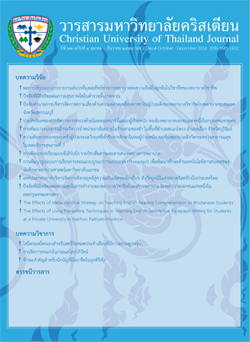การจัดการคนเก่งในกระแสโลกาภิวัตน์
บทคัดย่อ
บทความวิชาการนี้มีวัตถุประสงค์เพื่อทบทวนแนวคิดเกี่ยวกับความหมายการจัดการคนเก่ง ความเป็นมาของการจัดการคนเก่ง และการบริหารจัดการคนเก่ง จากนักวิชาการทั้งในไทยและต่างประเทศ ความหมายของคนเก่ง คือ กลุ่มคนที่สร้างผลการปฏิบัติงานที่ดีและสร้างเสริมความก้าวหน้าให้แก่องค์กรแต่ความเป็นมาของการจัดการคนเก่งในทศวรรษที่ 50 การบริหารจัดการจะมีลักษณะที่ตายตัวระบบการจัดการยังไม่เป็นมาตรฐาน ต่อมากลุ่มนักวิชาการชาวอเมริกันได้มีการกล่าวถึงแนวคิดกระแสหลักนี้กันอย่างถ้วนหน้าใน ปลายปี ค.ศ. 1990 และต้นยุค ค.ศ. 2000 พบว่าการบริหารจัดการคนเก่ง ประกอบไปด้วย 5 ภารกิจหลัก คือ (1) การมีแผนกลยุทธ์ (2) ระบบการสรรหาและคัดเลือก (3) การสร้างแรงจูงใจและการพัฒนาคนเก่ง (4) การวิเคราะห์แผนดำเนินงานและการรักษาคนเก่งและ (5) การสร้างความร่วมมือเพื่อสร้างคนเก่ง
เอกสารอ้างอิง
กฤติพงศ์ เดชส่งจรัส. (2555). Talent Management ตอนที่ 8 การบริหารคนเก่งที่จะมาแทน. [ออนไลน์]. สืบค้นเมื่อวันที่ 20 สิงหาคม พ.ศ. 2557, จาก https://www.gotoknow.org/blogs/posts/485112.
ไกรสิงห์ จินตนา. (2557). Talent Management (การบริหารจัดการคนเก่ง). [ออนไลน์]. สืบค้นเมื่อวันที่ 1 มีนาคม พ.ศ. 2558, จาก https://www.academia.edu/6365400/TALENT_MANAGEMENT.
จีระ หงส์ลดารมภ์. (2550). การจัดการเรียนรู้. กรุงเทพฯ: ดอกหญ้า.
ชลิดา นภาพิพัฒน์. (2553). "การจัดการคนเก่งในศตวรรษที่ 21 (Talent Management for the Twenty-first Century)". จุลสารสมาคมผู้ตรวจสอบภายในแห่งประเทศไทย. 57(3): 1-10.
เด่นพงษ์ พลละคร. (2551). การนำความรู้ทางทฤษฎีการบริหารบุคคลไปใช้ปฏิบัติ. กรุงเทพฯ: มหาวิทยาลัยรังสิต.
ธเนศ ยุคันตวนิชชัย. (2552). "การจัดการคนเก่งขององค์กรบริหารส่วนจังหวัดในเขตภาคอีสานเหนือตอนบน". วารสารมนุษย์ศาสตร์และสังคมศาสตร์. 28(1): 7-15.
ปรียาพร วงศ์อนุตรโรจน์. (2553). จิตวิทยาการบริหารงานบุคคล. กรุงเทพฯ: ศูนย์สื่อเสริมกรุงเทพ
พรรัตน์ แสดงหาญ. (2556). "การธำรงรักษาคนเก่งในองค์กร". วารสารนักบริหาร. 33(3): 33-38.
พัลลภา เอี่ยมสอาด. (2552). การสร้างระบบการบริหารจัดการคนเก่งของกรุงเทพมหานคร. ภาคนิพนธ์การศึกษาตามหลักสูตรรัฐศาสตรมหาบัณฑิต สาขาบริหารรัฐกิจ คณะรัฐศาสตร์ มหาวิทยาลัยธรรมศาสตร์.
วิจารณ์ พานิช. (2555). วิถีสร้างการเรียนรู้เพื่อศิษย์ในศตวรรษที่ 21. กรุงเทพฯ: มูลนิธิสดศรี-สฤษดิ์วงศ์.
สุกัญญา มกุฎอรฤดี. (2551). Talent Management กับงานบริหารทรัพยากรมนุษย์ในงานห้องสมุด. กรุงเทพฯ: โดมทัศน์.
สุกัญญา รัศมีธรรมโชติ. (2554). พัฒนาดาวเด่นเพื่อองค์กรเป็นเลิศด้วย Talent Management by Competency-Based Career Development and Succession Planning. กรุงเทพฯ: สถาบันเพิ่มผลผลิตแห่งชาติ.
สุดารัตน์ โยธาบริบาล. (2557). สิงคโปร์กับสงครามการแย่งชิงคนเก่งทั่วโลกสู่ "ศูนย์กลางคนเก่ง สิงคโปร์": บทเรียนและความท้าทายสู่แนวทางสร้าง "ศูนย์กลางคนเก่งภาครัฐไทย" ในบริบทอาเซียน. รัฐประศาสนศาสตรดุษฎีบัณฑิต สาขาวิชานโยบายสาธารณะและการจัดการภาครัฐ ภาควิชาสังคมศาสตร์ คณะสังคมศาสตร์และมนุษยศาสตร์ มหาวิทยาลัยมหิดล.
สุนันทา เลาหนันทน์. (2556). การบริหารทรัพยากรมนุษย์. กรุงเทพฯ: ธนการพิมพ์.
Beechler, Schon and Woodward, Ian. (2009). "The global war for talent". Journal of International Management. (15): 273-285.
Boston Consulting Group and World Federation of People Management Association. 2012). Creating people advantages 2012. [online]. Retrieved on August 5,2013, from https://www.shrm.org/Research/SurveyFindings/Articles/Documents/BCG_Creating_People_Advantage_ Oct_2012.pdf.
Bratton, J. and Gold, J. (2007). Human Resource Management: Theory and Practice. Hampshire: Macmillan.
Chuai, X. (2008). Is talent management just old wine in new bottles?: the case of multinational corporations in Beijing. Doctor Dissertation. [online]. Retrieved on July 4, 2013, from https://tees.openrepository.com/tees/handle/10149/112660.
Goffee, R., Jones, G., and Mundt, T. (2007). "Leading clever people". Harvard Business Review. 85(3): 72-79.
Jones, Gareth R. (2007). Organizational theory, design, and change. N.P.: Pearson International Edition.
McShane, Steven L. and Gilnow, Mary Ann Von. (2007). Organizational Behavior (Essentials). New York: McGraw-Hill.
Porter, M. E., and Kramer, M. R. (2011). "The big idea: Creating shared value-how to reinvent capitalism-and unleash a wave of innovation and growth". Harvard Business Review. 89(1): 1-17.
Samuel, M. and Chipunza, C. (2009). "Employee retention and turnover: Using motivational variables as a panacea". Journal of Business Management. 3(8): 410-415.
Schweyer A. (2004). The Talent Management: Best Practices in Technology Solutions for Recruitment, Retention and Workforce Planning. Canada: Wiley.
Somaya, D., Williamson, I., and Lorinkova, N. (2008). "Gone but not lost: The different performance impacts of employee mobility between cooperators versus competitors". Academy of Management Journal. 51(1): 936-953.
Srivastava, P., and Bhatnagar, J. (2008). "Talent acquisition due diligence leading to high employee engagement: Case of Motorola India MDB". Industrial and Commercial Training. 40(5): 253-260.
Ulrich, D., Brockbank, W., Yeung, A., and Lake, D. (2006). "Human resource competencies: An empirical assessment". Human Resource Management. 34(4): 473-495.
Waheed, S., Zaim, A., and Zaim, H. (2012). "Talent management in four stages". The USV Annals of Economics and Public Administration. 1(15): 130-137.



